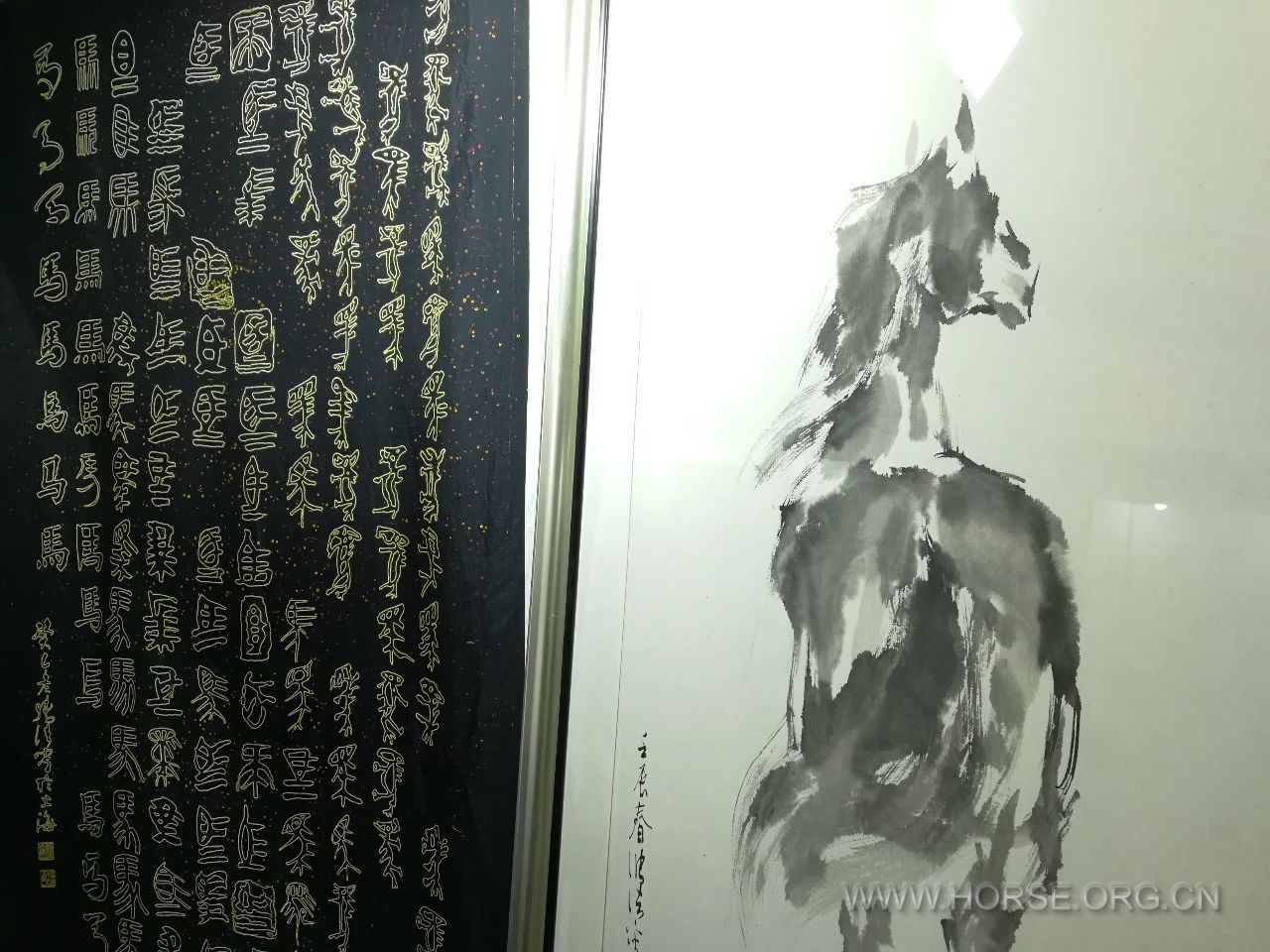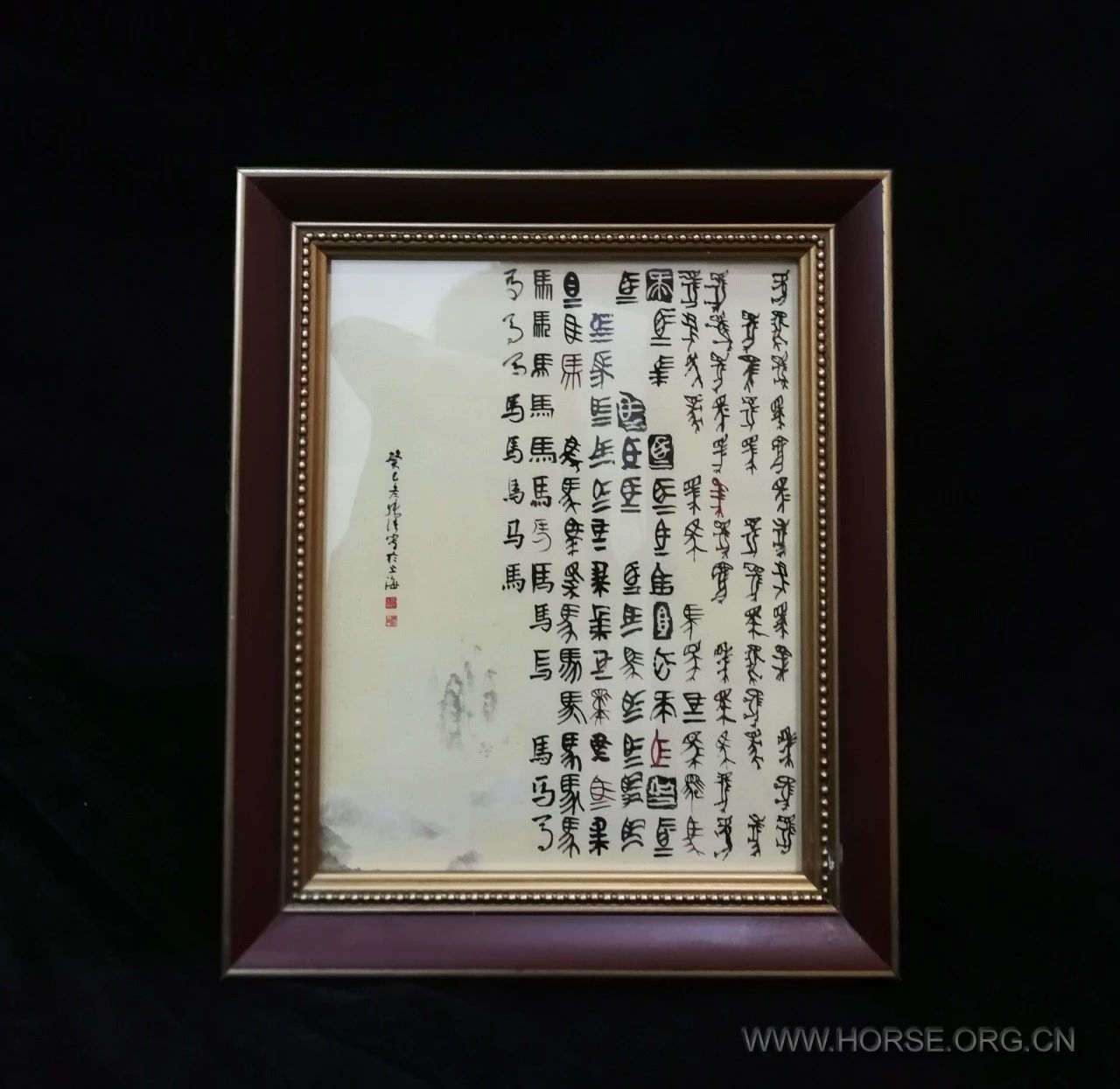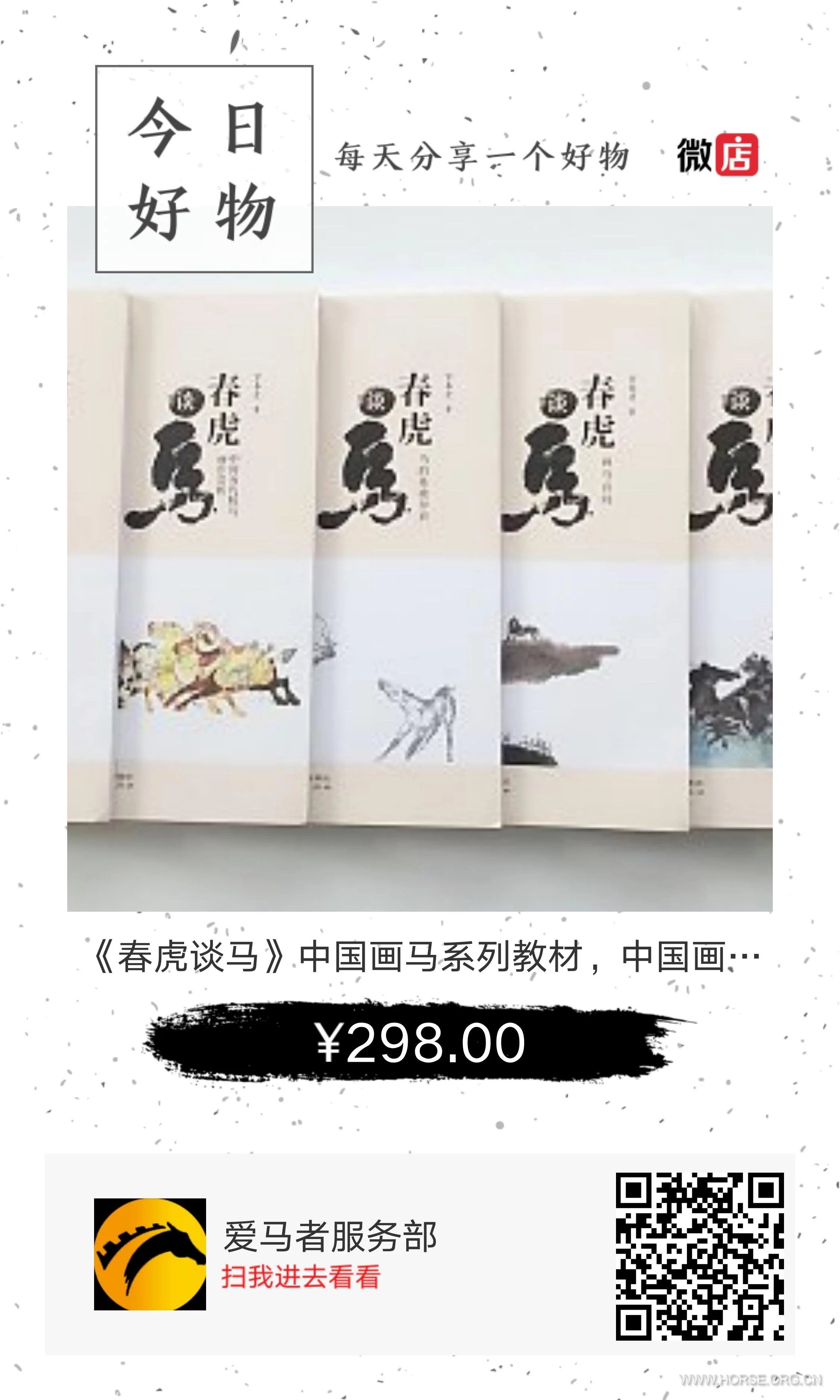马上注册,结交更多马友,享用更多功能
您需要 登录 才可以下载或查看,没有账号?立即注册
x
导读:
中国是世界马种的发源地和养马最早的国家之一。在山东和湖南境地发掘的远古马化石,都出现于始新世地层,距今约5000多万年。《新唐王·王求礼传》中讲到“自轩辕以来,服牛乘马,今辇以人负,则人代畜。”从史料中不难看出,在中国马匹被驯化和使役约在4000~5000多年前。中国对马字的表达,从象形记录开始——甲骨文。
《百马字》,张浩先生执教伦敦大学时,作为当时的教学教材,受到了同学和老师们的热捧和喜爱。通篇120个“马”字,生动呈现了从甲骨文到今天的各个时期的“马”字的演变和发展,且从“马”字形变上也反应了中国不同时期的社会发展和文化文明的特征。一个“马”字便拉开了中国几千年文明发展的大幕,清晰呈现历史演进的脉路。这是文化的经典传承,亦是艺术的精湛之诣,一字之呈,如叙万万字,又何尝不是一代大观之作?
百马字
《 100 Chinese Characters of Horse 》
尺寸:98 x 178 cm
纸本彩墨

中国马文化源远流长,我在对世界马文化研究过程中发现了一个有趣的现象:汉字,这个中国文化之载体在数千年的发展演进中,承载着很多中国马文化的重要信息。将其梳篦筢理,廓清脉胳,不仅开拓了中国马文化研究中新的领域,更由于汉字属于历史上硕果仅存的象形文字,可以认为,这是世界马文化中的一朵奇葩。另外,因中国文字的图型特征,我将现代艺术溶入其间而形成作品的独特美感,亦是令人欣喜的。
TheChinese horse culture has a long history of development. In my research to the world horse culture development, it’s found interesting to have a review of the evolution of the Chinese characters, a significant symbol of China’s civilization in past thousands of years, from which we can dig out lots of information important to the research of the Chinese horse culture, one of the key parts of the world horse culture.
Itis of a new field of the Chinese horse culture research to trace the origin of the Chinese character of “horse” with a review of the track of its evolution progress. The exploitation of such a new field has an extra significance to the world horse culture research because the Chinese character is the sole survival of the hieroglyphs today over the world.
中国马会 文化墙
商代之前
Before Shang Dynasty
中国自古就有“书画同源”一说,这是因为最早的文字来源就是图画,书与画好比是兄弟,同根生,有很多内在的联系。汉字的起源就是原始的图画,是原始人在生活中用来表达自己生活的图画形式。这种形式在漫长的历史中逐渐规范化,结果从原始图画逐渐演变成了一种表意符号。
In China, there has been a famous saying since the ancient time: “Picture and calligraphy share a common origin”. It was simply because the Chinese characters were evolved from pictures. That’s why in Chinese people’s eyes picture and calligraphy is a pair of brothers with countless ties of blood.
The primitive people in China used pictures to express themselves in their daily life. Gradually, the pictures were normalized and eventually turned out to be ideographic symbols.
中国马会主席贾幼陵先生&中国驻加拿大大使梅平先生
殷商时期
Yin-Shang Periad
大约是在公元前14世纪,殷商后期。表意符号演变成了比较定型的甲骨文。这些被刻在动物骨头上和乌龟龟甲上的文字,被认为是中国汉字的第一种形式。从殷墟中发现的甲骨文被认为是现代汉字的直系祖先,这是五千年中华文明载体的历史连续性的重要证明。
By the 14th century BC, during the late Yin-Shang (殷商) Dynasty, the ideographic symbols were developed into Oracle, the further normalized ideographic symbols carved on animal bones or tortoise shells. The Oracle is the most initial version of the Chinese characters.
The Oracles found from the ruins of the Yin-Shang (殷商) Dynasty are considered as the immediate forebear of the modern Chinese characters. The discovery of the Oracles proves the historical continuity of the born and the evolution of the Chinese characters, the symbol of the Chinese civilization.
现在,中东人多不能解读几千年前其祖先的象形文字,而中国人仍能读懂一些数千年前殷商时期的甲骨文。这些文字最初为占卜吉凶所用,古人认为把有关于疾病、梦境、狩猎、天时等一些疑问用一些象形苻号刻在甲骨上,用火烤烙,其间便自然产生裂纹,而占卜者则根据这些裂缝的形状和走向来判断所占之事的吉凶,这就是甲骨文。至今为止发现的甲骨文多达数千个,而被解读的已有一千多个。
Today, China is the sole nation over the world capable to spell over the ideographic symbols created thousands of years before. Most of the people in the Middle Eastern countries are unable to interpret their ancestors’ pictographic symbols nowadays.
The ideographic symbols carved on animal bones or tortoise shells were initially used for divination purpose. The ancient Chinese people tried to get answers for kinds of queries, such as those relating to diseases, dreams, hunting and climate, etc.
They burned the animal bones or the tortoise shells with the ideographic symbols carved on, and predicted their good or ill lucks based on the shapes and moving directions of the cracks occurred in burning.
So far up to thousands of pieces of Oracles have been discovered. Among the discovered Oracles, more than one thousand pieces have been interpreted.
从中国甲骨文中,我们发现马字出现的频率很高。这说明早在数千年前,马在中华民族的生活中,起了很重要的作用。据记,殷王每次出巡,所乘马车的几匹驭马的配置,须经多次占卜方能确定,以保证出行顺利。为了对数千年中国马字的演进过程有一个整体认识,我创作了《百马字》。这个作品的最初部分,便是先民们将图画之马简约成了规范化的甲骨文。但此时的马字仍具明显的图形特点,重点突出了马眼,
鬃毛和四蹄。
It’s noticeable that the characters of “horse” had a comparatively high rate of usage according to the study of the Oracles discovered. It indicates a fact that the horse has been always playing an important role in the Chinese people’s life since thousands of years ago.
According to the historical materials, during the Yin (殷) Dynasty in China, the number of horses to be used for King Yin (殷)’s carriage must be decided based on the divinations repeated for times, every time before King’s trip, to ensure safety and smoothness of the journey.
For getting a better understanding to the evolution of the Chinese character of “horse”, I make the “100 Chinese Characters of Horse (100 CCH)”, an artistic work with a comprehensive collection and an artistic presentation of the Chinese characters of “horse” in varied shapes and styles, respectively prevailed in China’s different historical periods.
The characters of “horse” available at the starting part of the “100 CCH” are those belonging to Oracles, the initial Chinese characters of “horse” developed from the pictures of “horse”. These characters kept many graphical features, with the emphasis on the eyes, mane and the four hoofs of the horse.
西周时期
Western Zhou Dynasty
青铜器的大量使用,而被刻在青铜的钟鼎和石鼓上的文字即――“金文”。亦有钟鼎文和石鼓文之称。相传是周宣王时期太史所创写。至今故宫博物院内存有十个周代的石鼓,上刻有十首四言诗文。这时,甚至有了周穆王“八骏”的传说。而马字在这个时期,比甲骨文有了更为工整而复杂的表达。
Along with the popular application of the bronzes during the Western Zhou (周) Dynasty, the Chinese people started carving the characters on bronze-made vessels as well as drum-shaped stones.
These characters were called “JinWen (金文)”, also known as “ZhongDing Wen (钟鼎文)” or “Shi GuWen (石鼓文)”, respectively indicating the carriers on which the characters were carved.
According to legend, the “JinWen (金文)” was innovatively carved on bronzes by a court historian who worked for the King Xuan (宣) during the Zhou (周) Dynasty.
So far the Palace Museum is keeping ten pieces of drum-shaped stones respectively with the “JinWen (金文)” carved on. Every one piece of the “JinWen (金文)” is a four-word poem, a pattern of poem prevailed in ancient China.
The famous legend about the King Mu (穆)’s “Eight Elegant Horses (八骏)” started spreading during the Zhou (周) Dynasty.
During the Zhou (周) Dynasty, the Chinese character of “horse” became more neat-looking and more complicated in structure compared with that of Oracles.
而金文多数呈现是王室的法律或重要事件记录,这似乎应该视为在周朝,马文化在王室政治和军事中愈发得到重视的一种佐证。因这些字是在青铜器上发现的,我特意使用些铜绿色来表达,一来突显此类字体的来源,二是能艺术体现整体《马百字》色彩的冷暖色彩交融变化。在我心目中,它不仅是中华汉字演进的历史记录,同时又是一件具有中华文化学术基奠和民主艺术风采完美结合的艺术品。总之,甲骨文和金文在汉字系统中是比较象形的一种文字,其注重的特征是马眼和鬃毛。
Most of the “JinWen (金文)” served as records of laws and key royal events. It seems to be the evidence indicates that the horse culture was attached more importance in royal political and military activities by the Zhou (周) Dynasty.
To present them in the “100 CCH”, I purposely used the copper green color to indicate their origin from the bronzes. It is also my intention to achieve a better vision effect through mixing warm and cold colors because in my heart, the “100 CCH” is not only a record of the evolution of the Chinese characters but a special artistic work.
In brief, the Chinese character of “horse” in both Oracles and JinWen (金文) had comparatively more pictographic features. They particularly highlighted the eyes, mane and the four hoofs of the horse.
在这时期,同时出现的陶文和鸟书也以其质朴和纤巧体现了工匠们在不同器物和地区对马字的艺术表达的多样化。
During the same time, “Tao Wen (陶文)” and “NiaoShu (鸟书)” emerged in China as well. The former were the characters carved on potteries, while the latter were those vividly imitating birds. The character of “horse” was therefore written respectively in different style by the ancient Chinese people lived in different regions.

春秋战国时期
Spring and Autumn Period
春秋战国是中华民族衍化成型过程中数国纷争时期,从思想史上讲,又是一个百家争鸣的时代。从这时期的马文字发展来看,逐步形成了其三大特点。首先,各国都有各自通行的马字,形象不一,出现了突出头部,简化马身之特点;其次,由于“司马”(最高军事长官)之职确立,马字出现在当时印玺之中;第三,自赵武灵王“胡服骑射”发展了骑兵之后,中国战马的功能从拖拽战车发展到士兵骑乘,马的奔驰的速度形象更为突出,这种现象在马字上的反映,是其鬃毛的刻划愈发上扬飘逸起来。
The Spring and Autumn Period, also known as “Warring States Period”, is a time full of wars among the states in China. It was also known as an era of ideological contending, during which the Chinese character of “horse” gradually evolved into that with three major features.
Firstly, the characters of “horse” prevailed respectively in different state, though different in writing style, all kept the same focus on the head of horse while with other parts of the horse simplified.
Secondly, the character of “horse” started to be engraved on some royal seals, thanks to the establishment of the highest military position named “Si Ma (司马)”.
Thirdly, since King Wu Ling (武灵) of the State Zhao (赵) developed the cavalry shooting on horse and dressed in Hu–style uniform, upgraded uniform for soldiers’ easier movement, well known as “Hu Fu Qi She (胡服骑射)”, the role of the war-horse has been expanded from chariot dragger to soldier’s riding. As such the character of “horse” became that with the mane of horse flying higher because the galloping feature of the horse was better realized.
《 百马字》的中间版面基本属于战国的马字。战国时期中国文字进入了一个繁荣时期。战国之前的甲骨文和金文基本属于贵族专属文字,其局限在较小人群里,即占卜者和统治者高层为记录重要事件时使用文字。但到了战国期间,中国文字开始在整个社会普及,各个阶层都参与到汉字的使用和书写中来,它便发生了一个很明显的变化,其基本特征是马字在这个时期变得易于书写。
Most of the Chinese characters of “horse” presented in the middle part of the “100 CCH” are those prevailed during the Warring States Period, a booming time of the evolution of the Chinese character of “horse”.
Before the Warring States period, both Oracles and “JinWen (金文)”were mainly used by nobilities. The application of the characters was confined to small groups of senior officials, who kept records of key events with Oracles and JinWen (金文).
By the Warring States Period, the Chinese characters started to be used by all levels of society. As a result, the Chinese character of “horse” experienced an obvious change: it was further simplified for easier hand writing, which was an important feature of the character of “horse” in this period of time.
马的形象仅仅突出眼睛和鬃毛,它的身躯被两道横划夸张的抽象了。这时,另一个特别有趣的现象是马鬃的表达从直笔变成了曲笔。我们可以认为,汉字的变化本身就是社会生活变化的折射。自“胡服骑射”之后,中国有了骑兵,而骑乘者对马的速度和奔驰中的感受,反映在文字上自然是马身运动速度之抽象和风鬃雾鬣之豪气。
The body part of the horse was simply abstracted with two horizontal strokes. Only the eyes and mane of the horse were particularly highlighted. And it’s also interesting to notice that the presentation of horse’ mane was changed from previously a strait stroke to a curved one.
With the mane flying into the air, the Chinese character of “horse” became that with a bigger emphasis on horse’ energetic feature demonstrated in galloping, since the establishment of the cavalry shooting on horse and dressed in Hu (胡)-style uniforms when the Chinese people knew the horse better through its galloping.
秦时期
Qin Dynasty
秦击败六国与战马的合理使用有关。由于秦王马政格外重视战马品种之改良和骑兵的训练以及战术使用,当时的秦马从数量和质量上已达七国之首,秦军作战的机动性便大大提高。这对其军事霸权的确立起了重要的作用。嬴政称帝后,统一文字,统一度量,其功绩显著的就是派宰相李斯对当时的文字进行收集整理,然后进行删繁就简美化加工而形成统一文字形式。
The rational use of war-horses was one of the reasons the State of Qin (秦) eventually defeated the other six states during the “Warring States Period”, during which the King of Qin (秦) attached a great importance to breed improvement of the war-horses and the effective training of the cavalry. It made Qin (秦) on the top among the seven states in terms of both the quality and quantity of the war-horses, which greatly lifted Qin (秦) troop’s mobility.
After the Qin (秦) unification, the First Emperor of Qin (秦始皇) enforced the standardization of the characters, as well as the weights and measures. One of his remarkable achievements was the completion of the collection of all the characters used in different regions across the country, a task given and successfully done by then Prime Minister Li Si (李斯), who eventually worked out a set of unified characters by beautifully simplifying the characters collected.
这种统一后的文字被称为――“小篆”,亦称为“秦篆”。这个时候的文字几乎已经完全没有象形文字的痕迹了。马字在秦统一之后又有了一个重要变化,那就是马身体,包括尾和四蹄的重新规范。这就将甲骨文的四蹄向左的图型马字落实到四蹄向下的文字型马字,这比战国时期略为抽象而形象各异的马字,有了更为规则更加完善的意义。可以视为汉字“马”演进中的里程碑。
The unified characters were called “Xiao Zhuan(小篆)”, also known as “Qin Zhuan(秦篆)”, an ancient style of the Chinese calligraphy prevailed during the Qin (秦) Dynasty. By this time, the Chinese characters were almost completely free from any trace of hieroglyphs.
The Chinese character of “horse” experienced other significant change after the Qin (秦) reunification:a re-regulation of the structure indicating the tail and four hoofs of the horse.
It was a re-structuring of the character of “horse”, a relocation of the four hoofs of horse to the bottom of the character from previously on the left since the Oracle time.
Compared with the characters of “horse” prevailed in different with varied shapes in different states during the Warring States period, the character of “horse” during the Qin (秦) Dynasty was much better regulated with a better looking.
“草书”的起源,亦如行书,或其他书体,无法确指始于何时。史记说:“战国时,楚怀王使屈原造宪令,草稿未上,上官氏见而欲夺之,盖草书之祖起于。”据此故有草书缘起于草稿之话,可见战国时即已有草书的形成。因为起于草稿的字体,为了发挥速写功能,较为省略草率,自然不能工整,草草写成,顾名思义而为草书。但此种草书,仅能说是古篆(当时使用的字体)的草稿。
There is no specified information on the exact time of the origin of varied types of the Chinese calligraphies, such as “Cao Shu (草书)”, a cursive scrip, “Xing Shu (行书)”, a semi-cursive scrip, and many others.
It’s most likely, however, the “Cao Shu (草书)” was born during the Warring State Period because according to Shi Ji (史记), an ancient historical book, “during the Warring States Period, the King Chu Huai(楚怀) of the State Chu (楚) ordered Qu Yuan (屈原), a high-rank official as well as a famous poet, to draft a constitution.
Qu Yuan (屈原)’s draft of constitution was coincidently taken by a queen named Shang Guan (上官) before the formal submission. Since then the Cao Shu (草书) gradually became popular.”
As it was initially a draft written in hasty with no attention given to neat and tidy, the said “Cao Shu (草书)” was actually a drafting form of “GuZhun(古篆)”, the ancient Chinese calligraphy prevailed during the same period.
真正草书的开始发现,则始自汉初,其演变过程,自应是先有“章草”,而后又有“今草”,再又有“狂草”等草体了。由于楷书的工整,为了书写快捷的需要,和书者为了抒发自己的胸臆,寄情于笔端的创造,产生了一种流动顺畅,一气呵成,极具有韵律和艺术感染力的字体――“草书”。介于楷书和草书之间的就是“行书”,行书没有楷书那样规范严肃,也没有草书那样奔放和难以识别,而是优雅欢畅的运笔,字体书写灵活贯通。也是最受大众喜欢最常用的一种字体。马字的草书和行书充满了欢快和优雅。
The real “Cao Shu (草书)” was found since the beginning of the Han (汉) Dynasty. It experienced an evolution process from “Zhang Cao (章草),” a cursive script as similar as text drafting, to “JinCao (今草)”, an improved cursive script, and “KuangCao (狂草)”, a cursive script written with more freedom.
To be compared with “Kai Shu (楷书)”, a regular script featured with neat and orderly, the cursive script “Cao Shu (草书)” looks more artistic and fluent with a higher sense of rhyme and charm. It is written in a fast speed at one breath. It is a calligraphy transforming a calligrapher’s inner passion from heart to the paper through the writing brush.
“Xing Shu (行书)” is not as regularly looking as Kai Shu (楷书)”, nor as unidentifiable as “Cao Shu (草书)”. It is a semi cursive script in between the regular and cursive scripts. It is a type of the calligraphy looked elegant thanks to the way of writing with more freedom and flexibility. It is one of the most popular types of Chinese calligraphy today.
汉朝时期
Han Dynasty
隶书十分盛行,“秦隶”并没有完全摆脱“小篆”的结构特点,基本上是方形,而“汉隶”就完全发挥了毛笔的特点,出现了“蚕头雁尾”的波折之笔,书写起来轻松自如。西汉时期流行的这种隶书。称之为"汉隶"。这时,马字的四蹄抽象成为四点。
“Li Shu (隶书)”, one of major types of the Chinese calligraphy, became popular during the Han (汉) Dynasty, following its predecessor “Qin Li (秦隶)”, the “Li Shu (隶书)” popular in the Qin (秦) Dynasty, which was still heavily influenced by the basically square-looking “Xiao Zhuan(小篆)”, the ancient calligraphy hereinbefore mentioned.
The “Li Shu (隶书)” prevailed in the Western Han (汉) Dynasty, known as “Han Li (汉隶)”, was featured with its “bean-head and swallow tail” strokes, in Chinese “Chan TouYan Wei (蚕头雁尾)”, indicating the strokes with a powerful starting and a light or flying ending. It was an outcome of the better application of the writing brush. By this time the four hoofs of horse were further abstracted to be simply four points.

汉朝流行“汉隶”的同时,“楷书”正在萌芽阶段。到魏晋南北朝的时期已经很盛行,晋代的王羲之,王献之父子是楷书的真正创始人,同时吸取了篆书圆转笔画,也保留了隶书的方正平直,去掉了“蚕头燕尾”。使汉字的结构大体的固定了下来。当时被称之为――“真书”,后人因为以这种字体作为学习书法的楷模,即改称之为――“楷书”。这时的马字被沿续使用到今天。
The “Kai Shu (楷书)”, a regular script featured neat and orderly, was in its budding stage while the “Han Li (汉隶)” was prevailing during the Han (汉) Dynasty.
The “Kai Shu (楷书)” became prevailing by the time during the Wei, Jin, North and South Dynasties (魏晋南北朝). Wang Xizhi(王羲之) and Wang Xianzhi(王献之), the father and son, both the royal officials and famous calligraphers during the Jin(晋) Dynasty, should be respected as the real founders of “Kai Shu (楷书)”.
They took all the advantages of “ZhuanShu (篆书)” and “Li Shu (隶书)”,round- and smooth-looking of the former, square- and regular-looking of the later, and gave up the over-artificial looking of the “Han Li (汉隶)” with bean-looking heads and swallow tail-looking flying ends of all the stokes.
The “Kai Shu (楷书)” set up the fundamental structure of the Chinese characters prevailing even by today. It was initially hailed as “Zhen Shu (真书)”, meant “a real calligraphy”, and renamed afterwards as “Kai Shu (楷书)” because it was popularly used by later generations as a model of calligraphy learning.

中国文字与其他民族目前通行文字都不一样,即它至今保留着隶变之前许多象形文字特点。这幅百马字在创作过程中,我对中国马字的发展作了一种由古而今,一泻千里的纵览表达,并一改通常书法非墨即朱的风格,加入了褐色和青铜色,而有些字则直接按古玺描摹。并在一气呵成的书写过程中,又故意留下一些残断,不仅使作品疏密有致,也表示了中国马字文化研究还有待于新的发现。另外,总体上保持下稳上空之状,希翼整幅作品在庄重中不失灵动。
Different with all the other nation’s characters prevailing today, the Chinese characters are still keeping many hieroglyphic features, those before evolved into “Li Shu (隶书)”.
The motivation behind making the “100 CCH” is to present a whole picture of the Chinese characters’ evolution through the presentation of the key footprints of the evolution of the Chinese character of “horse”.
Unbounded by the conventional Chinese calligraphy, normally in black and red, I added brown and bronze colors to better showcase the historical background of relevant characters of “horse”.
The image of ancient royal seal was taken used as well for some of the characters of “horse” to highlight their historical position.
Some extra spaces among the words were purposely left to make the “100 CCH” more elegant-looking with varied density.
It’s also an indication of my expectation to make further achievements for the Chinese horse culture research through a continued study of the Chinese characters of “horse”.
The “100 CCH” was deliberately made loose-looking on the top part and intensive-looking in bottom, with an intention to get a better visual effect mixed with cheerfulness and solemnity.

《百马字》并非传统或现代的书法作品,而是一份通过对一个马字的研习,我对几千年中华文字演进的一个微型历史记录。它的原形是多年前在英国授课时的一份讲义。我期望通过对马文字的历史记录,诠释中华马文化的源远流长,并从一个“马”字演进的过程中,瞥见中国文字在各个重要发展阶段的某些特点,让喜爱中国文化和中国马文化的朋友们有一个不同的视角享受和兴趣。
It’s my pleasure to complete such a full presentation of the unique beauty of the Chinese characters through blending the modern art with the graphics Chinese characters.
It’s my expectation to open a window for more people to get a better view of the Chinese horse culture development through the “100 CCH”.
The “100 CCH” is not a calligraphic work but an artistically presented historical record of the evolutional features of the Chinese characters in China’s key historical periods.
张浩
Hao Zhang
国际马文化学者 艺术家
中国马会驻加拿大总代表
中国内蒙古农业大学客座教授
中国马文化艺术研究院研究员
Artist & Horse Culture Scholar
Chief Representative of China Horse Industry Association (CHIA/Canada)
Visiting Professor of China Inner Mongolia Agricultural University (IMAU)
Researcher of China Horse Culture & Art Academy
张浩早年于华东师范大学师从著名历史学家王养冲先生完成历史学博士课程。曾先后执教于上海同济大学、日本京都大学和英国伦敦大学。他在几十年中国文化的国际教育和文化交流中,独辟蹊径,以中华国学为灵魂,以世界名马为代表,以异域交流为平台,展示了当代中国学者新文人画的思想境界和艺术魅力。他曾多次在国际艺术展获奖,其作品因其中西合壁、典雅大气的鲜明风格,倍受国际知名爱马仕人群喜爱,并长期为各国艺术品藏家青睐和著名学院殿堂收藏陈列。
After completed his PhD studies in history in the 1980s at East China Normal University(ECNU), supervised by Mr. Wang Yangchong, a famous historian, Mr. Hao Zhang lectured at universities home and abroad including Shanghai Tongji University ,Kyoto University in Japan and London University in UK.
Mr. Hao Zhang's exclusively outstanding horse painting and calligraphy works have been repeatedly rewarded during varied international art exhibitions in different countries such as China, Britain, Japan, Korea, Canada. His talent and love of horses is clearly evident in many of his contemporary paintings, which artfully combined the spirit of Chinese water colours with a more Western aesthetic. His works are warmly welcomed by celebrated horse lovers all over the world and have also been collected by some famous artwork collectors.

|